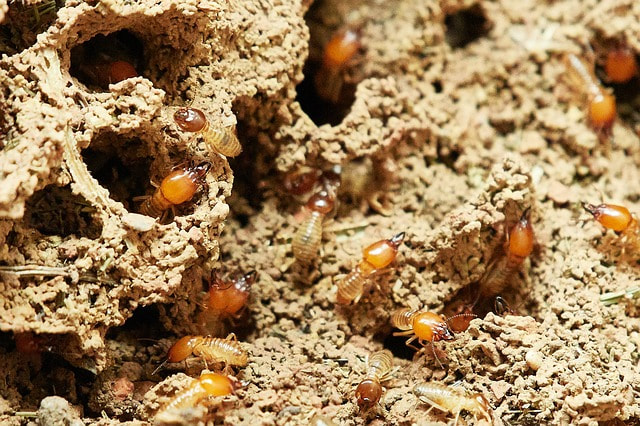
Termites are some of the most costly pests in the world. Each year they affect millions of homes and cost billions in property damage. While some areas are more susceptible to termites than others, homeowners everywhere should be on the lookout for them. Early intervention can greatly reduce the damage that they do to your home and the costs associated with eliminating them. Here are some signs of termites to look for.

Mud Tubes
One of the most obvious signs of a termite infestation is the presence of mud tubes. Some species of termites builds mud tubes from their underground home to a potential food source like a tree, shed, or home. These tubes are necessary because they help the termites maintain the right humidity level and temperature. Mud tubes are about the width of a pencil and can often be seen on the foundation of homes
Termite Swarms
During the spring and summer, termite reproductives take part in a ritual flight where they swarm together in search of a mate. Termites are not very good flyers and do not travel far, so if you see a swarm near your home, chances are good that there are lots of termites in the area, all looking for a place to settle down and reproduce. You can tell the difference between a termite swarm and an ant swarm by looking at the insect’s waist. Ants have a pinched waist, and termites have a wider, straight waist. Termites also have two pairs of equal length wings, while ants have longer front wings and shorter back wings.
Piles of Wings
Once the swarming termites have found a mate, they will land, twist off their wings, and start eating away at their new home. Piles of termite wings that have collected near doors and windows are a bad sign and immediate action should be taken to protect your home.
Wood Damage
Termites chew through and eat wood in order to get the cellulose that it is made of. As they eat, they will leave grooves behind that form a sort of maze. With the passage of time, these grooves will start to weaken the structural integrity of the wood. This is why sagging or squeaking floors, fragile baseboards, and hollow sounding wood can all be signs of termites.
Moisture Damage
Termites require high levels of humidity in order to survive. They have salivary reservoirs where they can store water to help increase the humidity in their mud tubes and nests. This humidity may start to show on the outside of walls and is another sign of termite activity. You may see damp spots on walls, discolored drywall, peeling paint that looks to have suffered water damage, or tight windows or doors that have swelled from the excess moisture.

Piles of Frass
Termite droppings are known as frass. Frass often looks like salt and pepper. Since the galleries that termites carve in the wood are so narrow, they need to clear out the excrement. They will create holes in the wood and push the frass out into piles. Seeing piles of frass along decks, around the exterior of the home, or along baseboards indicate a termite problem.
Toronto Termite Control
Termites can be extremely frustrating to find and deal with, but you do not have to handle it alone. GTA Toronto Pest Control is one of the top termite control and removal services in the area. We can work with new builds to help protect homes from ever getting termites, and we can help eliminate them from homes with current infestations. For termite control in Toronto, Vaughan, Brampton, and other surrounding areas, trust GTA Toronto Pest Control to get the job done right.









